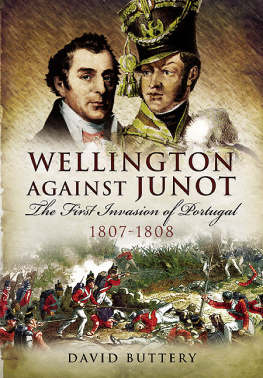Copyright Mark S. Thompson, 2015
The right of Mark S. Thompson to be identified as the author of this work has been asserted by him in accordance with the Copyright, Designs and Patents Act 1988.
A CIP record for this book is available from the British Library.
All rights reserved. No part of this book may be reproduced or transmitted in any form or by any means, electronic or mechanical including photocopying, recording or by any information storage and retrieval system, without permission from the Publisher in writing.
Pen & Sword Books Ltd incorporates the imprints of Pen & Sword Archaeology, Atlas, Aviation, Battleground, Discovery, Family history, history, Maritime, Military, Naval, Politics, Railways, Select, Social history, Transport, True Crime, Claymore Press, Frontline Books, Leo Cooper, Praetorian Press, Remember When, Seaforth Publishing and Wharncliffe.
Acknowledgements
Whilst I have always been interested in the Peninsular War, my knowledge of the Royal Engineers, like that of most people, was very limited. My interest stemmed from trying to find a topic for a PhD that had not been covered before. Ten years later, I have my bit of paper but also knowledge that I would like to share with others. There have been challenges in my research, mainly because the Corps is almost invisible in most histories of the period. Where an engineer appears in Wellingtons dispatches it is usually difficult to find any further evidence of the events mentioned. Even the official Corps history, although admittedly written over 100 years ago, has big gaps in its coverage of the Peninsular War. Fortunately we have a number of diaries and letters that we can use to reconstruct the Engineers story one piece at a time.
Information on the other units involved in engineering activities is even scarcer. The Royal Staff Corps, the armys equivalent, has no history and no personal diaries; similarly the engineers of the Kings German Legion. Although almost completely ignored in the Anglo-centric writings on the Peninsular War, the Portuguese and Spanish engineers did play their part. I have not done much better, but have tried to acknowledge their presence where I found it.
In my search to rebuild the engineers story, I have had help from many people who have given their time, knowledge and enthusiasm freely and I thank them all. The first and foremost came from a chance encounter at the Royal Engineers Museum in 2004. Julia Page, known for her excellent book on Edward Charles Cocks and also for many years as an expert tour guide, shared my interest in the Royal Engineers. Later that year, with the battlefield tour group the Forlorn Hope, we spent a week going over the ground of many of the events recounted in this book. She is the only other person in the world with whom I can share my enthusiasm. Julia also planned to write a book on the Corps and had even started it. Unfortunately lack of time has interfered and it is left to me to bring this subject to the reader. This book is as much Julias as mine.
It is difficult to know where to start with the others who have helped me. Rory Muir is a hidden presence behind many modern works. His knowledge of the history is unparalleled and I have learnt so much from reading his books and talking to him. The other side of Rory is the man who willingly shares his knowledge with all and is always there when you have a question. He feels more like my next-door neighbour than someone who lives 10,000 miles away. I know that I am not the only person who has benefited from his generosity, so on behalf of us all, thank you.
During my research, I have made a number of visits to the Royal Engineers Museum and Library at Chatham. They have met with my many requests with patience and diligence and I would particularly like to thank Rebecca Nash and her team. I would also like to thank serving and retired members of the Corps for their assistance and encouragement, particularly Gerald Napier, San Scullion and Martin Stoneham. I first met Gerald Napier when we co-presented a session on the Lines of Torres Vedras and this led to my involvement in the Friends of the Lines of Torres Vedras (please look up our website and Facebook pages). I would also like to thank Nick Lipscombe for his advice and support.
In Portugal there are two people to I particularly need to mention. Firstly, Clive Gilbert, Chairman of the British Historical Society of Portugal. If you are ever visiting Portugal and need a local expert, you need Clive. He is heavily involved in local activities to protect and promote the Lines of Torres Vedras and is a superb interface between Portuguese and British interests. Secondly, I would like to thank Isabel Luna who works on the preservation of the Lines and is particularly heavily involved at Torres Vedras itself. She has been very supportive of my research and particularly in the efforts to identify the names of places and people in the unpublished diary of Edmund Mulcaster. There have been several others in Portugal who have contributed to my research, including Jos Paulo Berger, Joo Torres Centeno, Carlos Cunha, Flor Estavo, Moiss Gaudencio, Rui Moura, Jorge Quinta-Nova, Rui Sa Leul and Sergio Tavares. In the same group, although not Portuguese, is Anthony Gray.
From the British Commission for Military History (BCMH), I would particularly like to thank Dick Tennant and John Peaty. We have had a number of healthy debates about the war in general but particularly around bridging and military surveying. It was Dick who invited me to one of their conferences where I found myself speaking at Sandhurst next to the late, great Richard Holmes, an experience I will not forget for many reasons. The battlefield tour with them in 2012 is also a memory I will treasure.
Whilst not a regular contributor myself, I must recommend the Napoleon Series (
One constant in my life as a historian has been the presence of the British book dealer Ken Trotman, run by Richard and Roz Brown. I have been buying books from them for over thirty years and many of the books on my shelves came from them. I also owe them special thanks for allowing me to use images from some of their reprints.
I cannot end without giving my thanks to Chris Woolgar and Karen Robson at Southampton University, both for answering my questions and for arranging the Wellington Congress. I also must thank the staff of the British Library, the National Archives and the National Army Museum for their help in providing material for my research.
My final thanks are to my family who have lost me for a second time to Fletcher and his officers. Their understanding when I locked myself away for days on end and over my business trips to London, Portugal and Spain have always been met with understanding and patience. This book and the PhD that preceded it are the result of the support of Team Thompson. The credit for this book should go to you, Trish, my wife and daughters, Ruth and Katherine.
Mark S. Thompson
October 2014
Foreword
It is well over one hundred years since Major General Whitworth Porter included an account of the Peninsular War when writing Volume One of the History of the Corps of Royal Engineers . This book now draws on much new material, not previously available, to tell the story from the perspective of engineer officers and explains how they supported the victories of the Duke of Wellington in the Iberian Peninsula. These officers from the Royal Engineers, never more than fifty at any one time, played a highly significant, but mainly invisible role in supporting Wellingtons army and the operations in Spain and Portugal. They were present at almost every major engagement, but their roles as staff officer, liaison officer, bridge and road builder, and fortifications engineer are not well recognised. A number of them lived to enjoy rank and high reputation, while others died in the breach of a stormed city, leading the infantry into the gap in the enemys defences as Sapper officers should. It is now time that all their various contributions are better understood.















